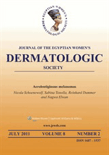
CUTIS
Scope & Guideline
Connecting knowledge and practice in skin health.
Introduction
Aims and Scopes
- Clinical Dermatology:
The journal publishes original research and case studies that delve into various skin conditions, treatments, and outcomes, aiming to enhance clinical practice and patient care. - Dermatopathology:
CUTIS features studies that provide insights into the histological and pathological aspects of skin diseases, helping to improve diagnostic accuracy and understanding of disease mechanisms. - Public Health and Policy:
The journal addresses public health issues related to dermatology, including the impact of skin disease on different populations and the effectiveness of health policies and educational programs. - Innovative Treatments and Technologies:
Research on novel therapies, including biologics and targeted therapies, as well as advancements in dermatological procedures and technologies, is a core focus. - Patient Education and Wellness:
CUTIS emphasizes the importance of patient education, exploring strategies to empower patients and improve their understanding of dermatological health. - Diversity and Inclusion in Dermatology:
The journal is committed to addressing disparities in dermatological care and representation, focusing on research that highlights the needs of underrepresented populations in the field.
Trending and Emerging
- Teledermatology and Digital Health:
The COVID-19 pandemic has accelerated interest in teledermatology, with studies exploring its efficacy, patient satisfaction, and future applications in clinical practice. - Psoriasis and Atopic Dermatitis Treatments:
There is a growing emphasis on innovative treatments for chronic skin conditions, particularly psoriasis and atopic dermatitis, including biologic therapies and systemic treatments. - Psychodermatology:
Research on the psychological aspects of dermatological conditions is trending, addressing how mental health impacts skin diseases and vice versa. - Impact of COVID-19 on Dermatology:
The pandemic's effects on dermatology practice, patient care, and disease presentations are emerging themes, with research focusing on changes in practice patterns and patient outcomes. - Diversity in Dermatology:
There is an increasing focus on addressing health disparities, representation in dermatology, and the unique needs of diverse populations, reflecting a commitment to social justice in healthcare. - Artificial Intelligence in Dermatology:
The integration of AI technologies for diagnosing skin conditions and improving clinical efficiency is an emerging area of research, showcasing innovations in dermatological practice.
Declining or Waning
- Traditional Surgical Techniques:
While surgical techniques remain important, there has been a noticeable shift towards less invasive and more technologically advanced procedures, resulting in fewer publications on classic surgical methods. - General Dermatology Reviews:
The journal has seen a decline in broad review articles covering general dermatology topics, as the focus shifts towards more specialized and cutting-edge research. - Cosmetic Dermatology:
There appears to be a waning interest in purely cosmetic procedures and treatments, with a transition toward discussions that integrate cosmetic practices within broader dermatological health contexts. - Infectious Skin Diseases:
Research specifically focused on traditional infectious skin diseases has decreased, possibly due to the increasing focus on non-communicable diseases and emerging therapies.
Similar Journals

Acta Dermatovenerologica Croatica
Pioneering Research for Skin Health and BeyondActa Dermatovenerologica Croatica is a premier journal dedicated to the fields of dermatology and venereology, published by the Croatian Dermatovenereological Society. Established in 1994, this journal has been a vital platform for disseminating research and advancements in the understanding and treatment of skin diseases and sexually transmitted infections. Although it is currently classified in the Q4 quartile for dermatology, infectious diseases, and miscellaneous medicine, it provides a unique opportunity for emerging researchers and seasoned professionals to contribute to a growing body of knowledge. Based in Zagreb, Croatia, the journal emphasizes free access to information that enhances clinical practices and scientific understanding among dermatologists and venereologists worldwide. As the journal approaches its 30th anniversary, it continues to aim for excellence in research quality, fostering collaboration, and innovating in the ever-evolving fields it represents.

JOURNAL OF DERMATOLOGY
Illuminating the path to dermatological excellence.The Journal of Dermatology, published by Wiley, is a premier academic journal dedicated to advancing the field of dermatology, with its esteemed reputation reflected in its Q1 ranking in Dermatology and a remarkable Q2 ranking in Miscellaneous Medicine as of 2023. Since its inception in 1974, the journal has become a vital resource for researchers, clinicians, and students alike, covering pioneering studies and cutting-edge advancements in skin health and disease. With a Scopus rank of #32 out of 142 in the Dermatology category, placing it in the 77th percentile, the journal underscores its commitment to fostering knowledge and innovation within the dermatological community. Although the journal operates under a subscription model, it remains an essential platform for disseminating impactful research that shapes clinical practice and enhances patient care. For anyone invested in dermatological sciences, Journal of Dermatology serves as a key publication where critical insights and developments are regularly showcased.

Journal of Egyptian Womens Dermatological Society
Empowering Women's Health Through Dermatological ResearchThe Journal of Egyptian Women's Dermatological Society, published by Wolters Kluwer Medknow Publications, is an essential platform dedicated to advancing the field of dermatology through a valuable focus on women's health issues. Established to provide an open access outlet since 2019, this journal aims to disseminate research, case studies, and reviews that address the unique dermatological needs and concerns of women, particularly in the Egyptian context. Despite its current ranking in the Q4 category in dermatology and a Scopus rank of #117 out of 142 with a 17th percentile, the journal serves a critical role in fostering scholarly communication among researchers, clinicians, and academicians. With a commitment to promoting knowledge advancement and community engagement, this journal invites submissions that align with its objectives, specifically geared towards empirical research and innovative practices in dermatology impacting women's health.

CLINICAL AND EXPERIMENTAL DERMATOLOGY
Advancing Dermatological Science, One Study at a Time.CLINICAL AND EXPERIMENTAL DERMATOLOGY is a prominent journal in the field of dermatology, published by Oxford University Press. With an ISSN of 0307-6938 and an E-ISSN of 1365-2230, this journal has been a vital resource for researchers and practitioners since its inception in 1976. Recognized as a Q2 journal within the category of dermatology for 2023, it holds a respectable position, ranking #54 among 142 journals in this discipline, placing it in the 62nd percentile on Scopus. The journal is dedicated to publishing high-quality research that spans clinical and experimental aspects of dermatological science, making it an essential source of knowledge for advancing understanding and treatment of skin disorders. Although it operates on a traditional subscription model without open access options, its contributions to the field are significant, influencing both clinical practices and academic research. Researchers, clinicians, and students alike will find vital insights and contemporary themes presented in its pages, supporting ongoing education and innovation in dermatology.

INDIAN JOURNAL OF DERMATOLOGY
Advancing dermatological knowledge, one study at a time.INDIAN JOURNAL OF DERMATOLOGY, published by Wolters Kluwer Medknow Publications, is a renowned open-access journal that has been a significant platform for disseminating vital research in the field of dermatology since its inception in 1962. With an ISSN of 0019-5154 and an E-ISSN of 1998-3611, the journal covers a comprehensive array of topics relevant to skin health and diseases, serving both academic and clinical audiences in India and beyond. Having transitioned to an open access model in 2005, it strives to enhance the reach and impact of dermatological research. The journal is classified in the Q3 quartile within the dermatology category as of 2023 and ranks 82 out of 142 in Scopus, showcasing its contribution to the field despite competitive rankings. By fostering scholarly communication and providing a rigorous peer-review process, the INDIAN JOURNAL OF DERMATOLOGY remains a vital resource for researchers, practitioners, and students devoted to advancing the understanding and treatment of skin disorders.

Actas Dermo-Sifiliograficas
Empowering Knowledge in Dermatology and Forensic MedicineActas Dermo-Sifiliograficas, published by Elsevier España, stands as a pivotal resource in the realms of dermatology, histology, and pathology and forensic medicine. With its ISSN of 0001-7310 and E-ISSN 1578-2190, this esteemed journal has transitioned to an Open Access model since 2020, facilitating broader dissemination of impactful research. Operating from its Madrid headquarters, it has been a vital platform for scholarly exchange since its inception in 1945, continuing through its converged years until 2024. The journal holds a Q3 ranking in dermatology, histology, and pathology and forensic medicine as of 2023, reflecting its relevance in the academic community where it ranks 79th in dermatology and 126th in pathology among its peers. With a commitment to advancing knowledge and practice in its fields, Actas Dermo-Sifiliograficas serves as an essential repository for researchers, professionals, and students seeking to engage with the latest findings and innovative perspectives in skin and disease research.

Dermatologie
Unveiling Breakthroughs in DermatologyDermatologie, published by SPRINGER HEIDELBERG, is a prominent journal dedicated to the advancing field of dermatology. With its ISSN 2731-7005 and E-ISSN 2731-7013, this journal has established itself as a valuable resource for researchers, professionals, and students alike. Originating in Germany, the journal focuses on disseminating innovative research from 2022 to 2024, contributing significantly to the understanding of skin health and disease management. Despite its current ranking within the Q3 category in dermatology and a Scopus rank of #88/142, it provides critical insights and advances in clinical practice, epidemiology, and therapeutic modalities. With an emphasis on open discourse, it seeks to foster collaboration among healthcare professionals and researchers, thereby enhancing the quality and accessibility of dermatological research. Engage with Dermatologie to stay at the forefront of the latest advancements in skin-related health issues.

Dermatologica Sinica
Transforming Skin Care with Cutting-edge ResearchDermatologica Sinica, published by Wolters Kluwer Medknow Publications, is an esteemed open-access journal in the field of dermatology that has been disseminating critical research since its inception in 2005. With an E-ISSN of 2223-330X and an ISSN of 1027-8117, this journal presents a platform for researchers, clinicians, and students to share cutting-edge findings and advancements in dermatological science. As of 2023, it proudly ranks in the Q2 category of dermatology journals and holds a notable position at rank #62 out of 142 in the Scopus Medicine - Dermatology category, placing it in the 56th percentile for impact. The journal transitioned to an open-access model in 2016, enhancing accessibility and visibility for groundbreaking studies worldwide. With a commitment to fostering innovation in the dermatological community, Dermatologica Sinica aims to advance the understanding and treatment of skin diseases while encouraging scholarly dialogue among practitioners and researchers across the globe.

AMERICAN JOURNAL OF CLINICAL DERMATOLOGY
Exploring the Frontiers of DermatologyThe American Journal of Clinical Dermatology, published by Adis International Ltd, is a leading peer-reviewed journal dedicated to advancing the field of dermatology. With a notable impact factor and a prestigious Q1 rank in both Dermatology and Miscellaneous Medicine categories, this journal stands out as a valuable resource for researchers and clinicians alike, offering cutting-edge insights into clinical practice and innovative treatment strategies. Its comprehensive scope encompasses a broad range of topics within dermatology, addressing both common and rare conditions, with a focus on emerging therapies and technologies. As it converges its publication years from 2000 to 2024, the journal remains an essential platform for disseminating high-quality research to professionals striving to improve patient care and outcomes. With the ISSN 1175-0561 and E-ISSN 1179-1888, the American Journal of Clinical Dermatology facilitates greater accessibility to pivotal findings within the field, making it an indispensable resource for anyone involved in dermatological research and practice.

Przeglad Dermatologiczny
Connecting Researchers and Practitioners in Skin HealthPrzeglad Dermatologiczny is a peer-reviewed open-access journal published by TERMEDIA PUBLISHING HOUSE LTD, based in Poland. Since its establishment in 1951, this journal has been dedicated to advancing the field of dermatology by providing a platform for the dissemination of original research, reviews, and clinical case studies. With an e-ISSN of 2084-9893, it has gained recognition within the academic community, despite its current classification in the Q4 quartile of dermatological journals. The journal has been openly accessible since 2009, promoting wider dissemination of scientific knowledge, and is crucial for researchers, professionals, and students alike. While it holds a current rank of #105 out of 142 in the Scopus Dermatology category, the journal continually strives to enhance its impact through quality publications that address pressing dermatological issues. The diverse range of topics covered in the journal ensures it remains a vital resource for those looking to stay informed on the latest developments in dermatological research.